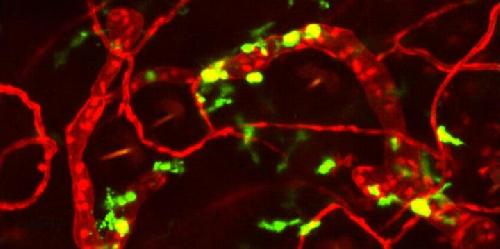Lymphatic vessels can be considered the pneumatic tubes of our immune system; the lymph nodes its control centres. Antibodies and killer cells, which are able to fight against pathogens invading our bodies, mature in these centres. It is through lymphatic vessels that information about these pathogens reaches the lymph nodes. An armada of sentinel cells, called dendritic cells, are decentrally positioned in tissues to take up pathogens. After uptake of the pathogen, the dendritic cells move into the lymphatic vessels and eventually trigger an alarm in the draining lymph node.
In larger lymphatic vessels, dendritic cells are passively transported by lymph flow. However, in the initial capillary vessels of the lymphatic vessel tree, where dendritic cells begin their migration, this is not the case. Here, lymph flow is too weak. Immunologists at ETH Zurich have now discovered how dendritic cells advance from the capillary vessels towards the lymph node. Lymphatic flow is still involved in this process, but only indirectly.
 Dendritic cells (green) are migrating actively within lymphatic capillaries (red; microscopic image). Credit: ETH Zurich / Erica Russo
Dendritic cells (green) are migrating actively within lymphatic capillaries (red; microscopic image). Credit: ETH Zurich / Erica Russo
A few years ago, Cornelia Halin, professor at the Institute of Pharmaceutical Sciences, and her team observed that dendritic cells migrate in a zigzag pattern within lymphatic capillaries (see ETH Life article from 09.08.2012). It is an active but rather inefficient, forward movement; Halin speaks of '"patrolling".
Molecular mediator with density gradient
But how do dendritic cells find the direction of the nearest lymph node? Erica Russo, a doctoral student in Halin's group, has succeeded in showing, in mice, that the cells orient themselves in the capillaries with the help of a molecular mediator named CCL21. "The inside of the capillary wall is lined with CCL21 molecules which increase in density in the direction of lymph nodes," explains Russo. Since dendritic cells have a receptor for CCL21, they manage to sense the direction - by "smelling" the higher concentration of the mediator.
Using, inter alia, cell culture experiments, the scientists were also able to determine why the concentration of the CCL21 signpost molecules increases in the direction of the lymph nodes. "The extremely weak flow in lymphatic capillaries is not strong enough to carry the cells along, however it is sufficient to move the CCL21 signpost molecules, which weakly interact with the vessel wall, in the direction of lymph nodes. This establishes a directional gradient, which the cells follow," says Russo.
For the time being, it is still unclear why dendritic cells do not move directly through lymphatic capillaries, but instead follow a zigzag course. One hypothesis, which Halin would like to further investigate, is whether the cells exchange information with the vessel walls or with other immune cells present within the vessel. This could potentially impact their function as immune sentinels.
source: ETH Zurich